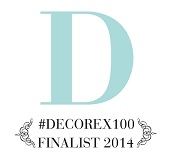I've always been a big fan of mother of pearl. There's something about the opalescence of shell that I find so elegant and totally glam. Skip the mirror; it's pearl for me.
Hardly a new material to enter into decoration, pearl inlays made their way into furniture in the late  Papier Mache Chair1600's. In fact, the Continental Rococo period took its name from the French word "rocaille" referring to the shell shapes and rock carvings that appeared in French furniture and wall appliques during the 18th century. My personal attraction to mother of pearl started with papier mache furnishings from the Victorian era. Victorians made dainty chairs low to the ground to accommodate women with fashionable hoop and bustle skirts. The papier mache versions of these chairs are lacquered with intricately patterned pearl inlay. The contrast of the black lacquer with the radiance of the inlay, while a little frou-frou, is for me just the right dose of drama to spice up an eclectic interior.
Papier Mache Chair1600's. In fact, the Continental Rococo period took its name from the French word "rocaille" referring to the shell shapes and rock carvings that appeared in French furniture and wall appliques during the 18th century. My personal attraction to mother of pearl started with papier mache furnishings from the Victorian era. Victorians made dainty chairs low to the ground to accommodate women with fashionable hoop and bustle skirts. The papier mache versions of these chairs are lacquered with intricately patterned pearl inlay. The contrast of the black lacquer with the radiance of the inlay, while a little frou-frou, is for me just the right dose of drama to spice up an eclectic interior.
Today, pearl decorates many surfaces, from bathroom tile to furniture to lighting. At the Architectural Digest Home Design Show last month, Artsaics displayed magnificent mosaics with mother of pearl tiles. (If you want ideas for bathroom designs, you MUST view their online catalog).


In furniture, I adore this chest by Wisteria. It's inlaid with bone instead of mother of pearl, but the look is similar. It's such a great piece. I could see it as a dining room buffet flanked by side chairs or as a living room end table.


Wisteria Chest with Bone Inlay Wunderley Chest with Mother of Pearl Inlay
Oly Studio has two great tables with mother of pearl inlay. The first, the Agnes Cocktail Table, is among several with a classic border design inlaid with mother of pearl. This table's simple lines yet classic border motif make it work in many room styles. The second, the Twilite Table of black resin, is that favorite size of mine--the same as ceramic garden stools. I'd love to see this table in a room with a predominantly white or pale palette. What a great accent!


Oly Studio Agnes Cocktail Table Oly Studio Twilite Table
In lighting, shells abound. I love the elegance and shimmer that mother of pearl table lamps add to an interior. These, by Jamie Young and Currey and Company would handsomely grace a night stand or living room end table.

 Jamie Young Lee Urn Lamp Currey and Company Barbados Table Lamp
Jamie Young Lee Urn Lamp Currey and Company Barbados Table Lamp
Decorating a seaside home? Then shells seem to be a must. I love the classic forms of these chandeliers and the whimsical touch they add by being made of shells.


Oly Studio Jenny Chandelier Arteriors Home Leeza Shell Chandelier
 Monday, April 23, 2012 at 11:00PM |
Monday, April 23, 2012 at 11:00PM |  Laurie Gorelick Interiors
Laurie Gorelick Interiors 






















